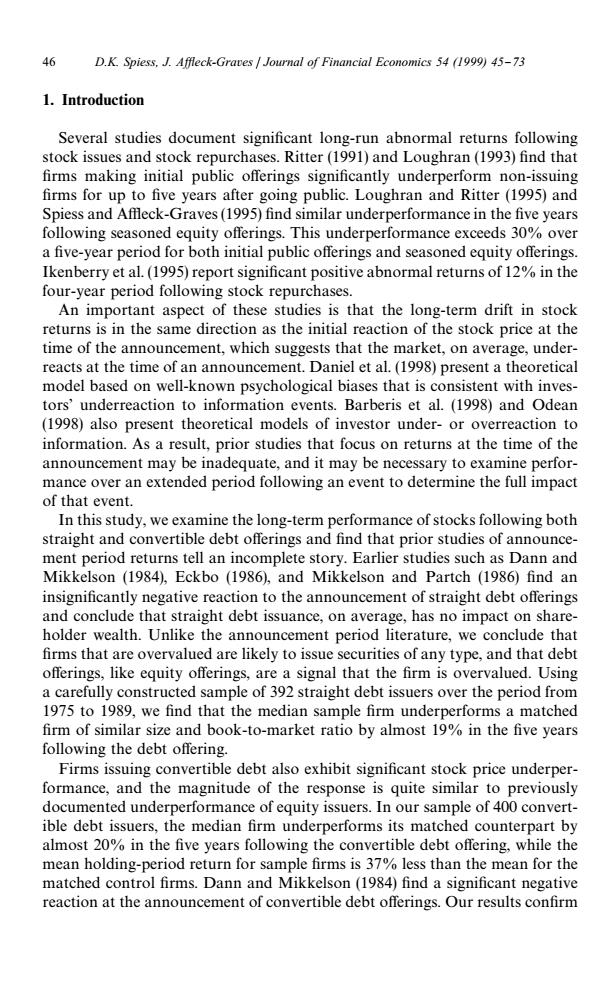正在加载图片...

46 D.K.Spiess,J.Affleck-Graves Journal of Financial Economics 54 (1999)45-73 1.Introduction Several studies document significant long-run abnormal returns following stock issues and stock repurchases.Ritter (1991)and Loughran(1993)find that firms making initial public offerings significantly underperform non-issuing firms for up to five years after going public.Loughran and Ritter(1995)and Spiess and Affleck-Graves(1995)find similar underperformance in the five years following seasoned equity offerings.This underperformance exceeds 30%over a five-year period for both initial public offerings and seasoned equity offerings. Ikenberry et al.(1995)report significant positive abnormal returns of 12%in the four-year period following stock repurchases. An important aspect of these studies is that the long-term drift in stock returns is in the same direction as the initial reaction of the stock price at the time of the announcement,which suggests that the market,on average,under- reacts at the time of an announcement.Daniel et al.(1998)present a theoretical model based on well-known psychological biases that is consistent with inves- tors'underreaction to information events.Barberis et al.(1998)and Odean (1998)also present theoretical models of investor under-or overreaction to information.As a result,prior studies that focus on returns at the time of the announcement may be inadequate,and it may be necessary to examine perfor- mance over an extended period following an event to determine the full impact of that event. In this study,we examine the long-term performance of stocks following both straight and convertible debt offerings and find that prior studies of announce- ment period returns tell an incomplete story.Earlier studies such as Dann and Mikkelson (1984),Eckbo (1986),and Mikkelson and Partch (1986)find an insignificantly negative reaction to the announcement of straight debt offerings and conclude that straight debt issuance,on average,has no impact on share- holder wealth.Unlike the announcement period literature,we conclude that firms that are overvalued are likely to issue securities of any type,and that debt offerings,like equity offerings,are a signal that the firm is overvalued.Using a carefully constructed sample of 392 straight debt issuers over the period from 1975 to 1989,we find that the median sample firm underperforms a matched firm of similar size and book-to-market ratio by almost 19%in the five years following the debt offering. Firms issuing convertible debt also exhibit significant stock price underper- formance,and the magnitude of the response is quite similar to previously documented underperformance of equity issuers.In our sample of 400 convert- ible debt issuers,the median firm underperforms its matched counterpart by almost 20%in the five years following the convertible debt offering,while the mean holding-period return for sample firms is 37%less than the mean for the matched control firms.Dann and Mikkelson (1984)find a significant negative reaction at the announcement of convertible debt offerings.Our results confirm1. Introduction Several studies document signi"cant long-run abnormal returns following stock issues and stock repurchases. Ritter (1991) and Loughran (1993) "nd that "rms making initial public o!erings signi"cantly underperform non-issuing "rms for up to "ve years after going public. Loughran and Ritter (1995) and Spiess and A%eck-Graves (1995) "nd similar underperformance in the "ve years following seasoned equity o!erings. This underperformance exceeds 30% over a "ve-year period for both initial public o!erings and seasoned equity o!erings. Ikenberry et al. (1995) report signi"cant positive abnormal returns of 12% in the four-year period following stock repurchases. An important aspect of these studies is that the long-term drift in stock returns is in the same direction as the initial reaction of the stock price at the time of the announcement, which suggests that the market, on average, underreacts at the time of an announcement. Daniel et al. (1998) present a theoretical model based on well-known psychological biases that is consistent with investors' underreaction to information events. Barberis et al. (1998) and Odean (1998) also present theoretical models of investor under- or overreaction to information. As a result, prior studies that focus on returns at the time of the announcement may be inadequate, and it may be necessary to examine performance over an extended period following an event to determine the full impact of that event. In this study, we examine the long-term performance of stocks following both straight and convertible debt o!erings and "nd that prior studies of announcement period returns tell an incomplete story. Earlier studies such as Dann and Mikkelson (1984), Eckbo (1986), and Mikkelson and Partch (1986) "nd an insigni"cantly negative reaction to the announcement of straight debt o!erings and conclude that straight debt issuance, on average, has no impact on shareholder wealth. Unlike the announcement period literature, we conclude that "rms that are overvalued are likely to issue securities of any type, and that debt o!erings, like equity o!erings, are a signal that the "rm is overvalued. Using a carefully constructed sample of 392 straight debt issuers over the period from 1975 to 1989, we "nd that the median sample "rm underperforms a matched "rm of similar size and book-to-market ratio by almost 19% in the "ve years following the debt o!ering. Firms issuing convertible debt also exhibit signi"cant stock price underperformance, and the magnitude of the response is quite similar to previously documented underperformance of equity issuers. In our sample of 400 convertible debt issuers, the median "rm underperforms its matched counterpart by almost 20% in the "ve years following the convertible debt o!ering, while the mean holding-period return for sample "rms is 37% less than the mean for the matched control "rms. Dann and Mikkelson (1984) "nd a signi"cant negative reaction at the announcement of convertible debt o!erings. Our results con"rm 46 D.K. Spiess, J. A{eck-Graves / Journal of Financial Economics 54 (1999) 45}73